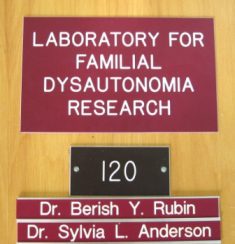TOCOTRIENOLS:
2003: Tocotrienols, a form of vitamin E, increase IKAP (now known as ELP1) protein levels in cells derived from individuals with FD. This is the first treatment developed for FD that addresses the underlying genetic defect on a molecular level.
2005: Tocotrienols reverse IKAP (now known as ELP1) and monoamine oxidase (MAO) deficiencies in individuals with FD.
2008: After 3-4 months of tocotrienol ingestion, patients experience: 1) a significant decrease in the number of crises; 2) a post-exercise increase in heart rate; and 3) a decrease in the QT interval as measured by an electrocardiogram. These findings clearly demonstrate that tocotrienol ingestion by individuals with FD results in a significant improvement in autonomic stability.
Those with FD taking tocotrienols report increased energy and stamina, and the ability to generate overflow tears, a reversal of a telltale FD symptom.
Click here to learn more.
EPIGALLOCATECHIN GALLATE (EGCG):
2003: EGCG, a compound in green tea, alters the splicing of the IKAP (now known as ELP1) RNA and dramatically increases the amount of IKAP (now known as ELP1) protein produced in cells of FD patients. The combined treatment of EGCG and tocotrienols results in a synergistic (greater than additive) increase in the amount of the IKAP (now known as ELP1) protein produced in cells from individuals with FD.
Those with FD taking both tocotrienol and EGCG combined report additional autonomic stability.
Click here to learn more.
VITAMIN A & BETA-CAROTENE:
2010: Vitamin A and beta-carotene increase IKAP (now known as ELP1) levels in cells derived from individuals with FD and in blood cells isolated from individuals ingesting these compounds. As a consequence of the ingestion of these compounds individuals with FD demonstrate increased autonomic stability. These supplements are taken in conjunction with the tocotrienols and green tea.
Those with FD taking tocotrienol, EGCG, vitamin A, and beta-carotene combined report additional autonomic stability.
Click here to learn more.
GENISTEIN:
2012: Isoflavones found in soy, including genistein and daidzein, correct the aberrant splicing of the IKAP (now known as ELP1) RNA in FD-derived and neuronal cells and mediate an increase in the level of the IKAP (now known as ELP1) protein. Treatment of FD-derived cells with the combination of genistein and EGCG raises the levels of the IKAP (now known as ELP1) protein to that observed in normal cells.
Those with FD taking tocotrienol, EGCG, vitamin A, beta-carotene, and genistein combined report additional autonomic stability.
Click here to learn more.
TYRAMINE-FREE DIET:
2005: The observed monoamine oxidase (MAO) deficiency in individuals with FD was groundbreaking, as it identified for the first time the triggers of hypertensive crisis in these individuals. A tyramine-free diet was developed for these patients and adherence to this diet was found to greatly reduce the incidence of these hypertensive crises.
Those with FD that eliminate tyramine from their diet report a significant reduction in their number of hypertensive crises.
Click here to learn more.
OLIVE LEAF:
2013: The ingestion of olive leaf extract alters the population of the microorganisms residing in the colon and restricts the growth of the tyramine-producing bacteria. Daily ingestion of olive leaf extract reduces the incidence of hypertensive crises in individuals with FD.
Those with FD that eliminate tyramine from their diet and take olive leaf report a significant reduction in their number of hypertensive crises.
Click here to learn more.
ROSEMARY:
2022: Rosemary extract and carnosol (a chemical compound present in rosemary) significantly elevate ELP1 (formerly called IKAP) levels in individuals with FD.
Combined with Drs. Rubin and Anderson’s other nutraceutical treatments, daily ingestion of rosemary extract helps to stabilize autonomic functions, including reduction of hypertensive crises, and increased tolerance to tyramine in individuals with FD.
Click here to learn more.
PROBIOTIC:
2016: A specific probiotic replaces tyramine-containing bacteria in the gut, helping to reduce morning nausea and vomiting.
Those with FD that eliminate tyramine from their diet, take olive leaf and a specific probiotic report a significant reduction in their number of hypertensive crises.
Click here to learn more.
FLOVENT AND PULMICORT:
2018: Inhaled corticosteroids, Flovent (fluticasone propionate) and Pulmicort (budesonide), increase the level of the MAO-A, an enzyme lacking in those with FD.
Those with FD that eliminate tyramine from their diet, take olive leaf, ingest a specific probiotic and inhale these corticosteroids report a significant reduction in their number of hypertensive crises.
Click here to learn more.
LOW PROTEIN DIET:
2010: Limiting protein intake in FD patients to the levels recommended by the Food and Nutrition Board, Institute of Medicine, National Academy of Sciences, reduces the number of hypertensive crises.
Those with FD that adhere to the tyramine-free diet and limit ingesting of protein to the daily recommended amounts report a dramatic decrease in the occurrence of hypertensive crises.
Click here to learn more.
IMPORTANCE OF CONTINUED ADMINISTRATION OF FD LAB’S THERAPIES DURING SURGERY:
2012: In a collaboration between the Fordham lab and a group at The Children’s Hospital of Philadelphia, a child with FD taking tocotrienols and EGCG-containing green tea extract (GTE) underwent a surgical procedure. While surgery and anesthesia in FD patients have, in the past, resulted in life-threatening autonomic instability and sometimes death, this FD patient, who was maintained on her regular doses of tocotrienols and GTE, exhibited no such autonomic instability. This publication represents the first report of the critical need for uninterrupted administration of these compounds in an FD patient who is scheduled to undergo a surgical procedure.
Click here to learn more.

